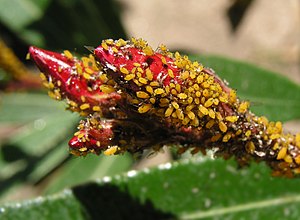Tube aphids
| Tube aphids | ||||||||||
|---|---|---|---|---|---|---|---|---|---|---|

A colony of oleander aphids ( Aphis nerii ) |
||||||||||
| Systematics | ||||||||||
|
||||||||||
| Scientific name | ||||||||||
| Aphididae | ||||||||||
| Latreille , 1802 |


The tube aphids or tube lice (Aphididae) are a family of plant lice (Sternorrhyncha) and belong to the superfamily of aphids (Aphidoidea). With around 2,000 species, they represent the largest family of aphids. Around 650 species occur in Central Europe .
features
The lice reach a body length of 1 to 8 millimeters. They have a soft body that is usually green, brown, or red in color. Like all aphids, they have two long siphons ( siphunculi ) on their abdomen with which they can excrete a defensive fluid. Their long antennae usually have four to six segments, rarely less. They have a proboscis and only very small compound eyes . Not all individuals have wings. When these are present, the fore wings, which have four to six veins, are larger than the hind wings. Their legs are short or long and thin, depending on the species.
Way of life
Green aphids feed on phytophagus by sucking sap from their host plants. They can usually be found on the soft, unwooded or less woody areas of the plants and on the leaves. Like many other aphids, they also excrete honeydew because they cannot absorb as many carbohydrates , but are dependent on amino acids in the plant sap. That is why they are "milked" by ants .
The winged animals are often transported far by the wind and can thus colonize areas further away. The wingless shapes are sluggish and move slowly. You can't jump either.
development
The tube aphids, like the other aphids, show a change between sexual and asexual reproduction through virgin generation ( parthenogenesis ). All species have both winged (aptere) and winged (alate) forms, with the former serving for mass reproduction and the latter for distribution and host change . This development is different depending on the species. In one group, the winged forms change the host plant, e.g. B. the black bean aphid ( Aphis fabae ). The other group develops in the same way, but the sexual generations live together on the same plant with the asexual one, e.g. B. the green apple aphid ( Aphidula pomi ). The succession of generations begins with eggs laid in autumn, the larvae of which hatch early in spring after overwintering.
The reproductive rate of green aphids is enormous. A new generation is fully trained within a week, which means that numerous generations can provide for offspring each year.
Harmful effect
Numerous types of tube aphids can cause considerable damage in agriculture : on the one hand, because they occur in large colonies and weaken the plants by sucking their sap, on the other hand, viruses can also be transmitted through the penetration of the proboscis . In addition, the excreted honeydew enables mold to settle , which can cause damage to the plant in addition to creating a dark coating. However, since the aphids have numerous enemies that feed on them, such damage is limited outside of human monocultures .
Types (selection)
- Anoecia corni
- Eriosoma Lanigerum ( Eriosoma lanigerum )
- Apfelfaltenlaus ( Dysaphis devecta )
- Pea louse ( Acyrthosiphon pisum )
- Great rose aphid ( Macrosiphum rosae )
- Great plum aphid ( Brachycaudus cardui )
- Green apple aphid ( Aphidula pomi )
- Green peach aphid ( Myzus persicae )
- Green plum aphid ( Brachycaudus helichrysi )
- Red currant aphid ( Cryptomyzus ribis )
- Mealy apple aphid ( Dysaphis plantaginea )
- Oleander aphid ( Aphis nerii )
- Black bean louse ( Aphis fabae )
- Sitkalaus , spruce tube louse ( Elatobium abietinum = Liosomaphis abietina )
- Soybean aphid ( Aphis glycines )
- Wickenlaus ( Megoura viciae )
- Brevicoryne brassicae
Web links
- Fam. Aphididae tube lice ( Memento from July 4, 2008 in the Internet Archive )
- British Insects: the Families of Hemiptera